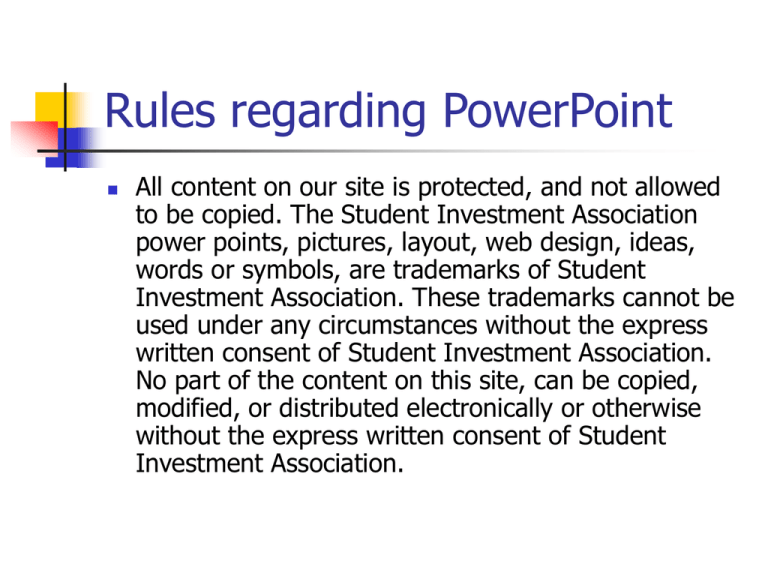Beginner Investor
advertisement

Rules regarding PowerPoint All content on our site is protected, and not allowed to be copied. The Student Investment Association power points, pictures, layout, web design, ideas, words or symbols, are trademarks of Student Investment Association. These trademarks cannot be used under any circumstances without the express written consent of Student Investment Association. No part of the content on this site, can be copied, modified, or distributed electronically or otherwise without the express written consent of Student Investment Association. Student Investment Association “The path to financial freedom” Steven Savickas & Panos Grivakis Announcements: Sign in on the attendance sheet Paid members (39$) receive copies Check Websites for updates. Next meeting Wednesday February 25th 7:15 pm 119 Eppley E-board meeting Sunday 11:30 am Business Library How do stocks work? Market price Bid price Ask price What is the single most important thing an investor should know? “Loeb was a highly successful investor and preached cutting all your losses short. And for me, this is rule #1. You must always protect your investment account. Particularly if you invest on marginm(use borrowed money) cutting losses is absolutely essential. Whether you’re a new or experience investor, the hardest lesson to learn is that you’re simply not going to be right all the time.” ~William J. O'Neil Loeb it was 10% Keys to success As a new investor, be prepared to take some small loses. Always cut your losses 8% below purchase price. Persistence is the key when learning to investing. Don’t get discouraged Learning to invest doesn’t happen overnight. It takes time and effort to become successful at it. Websites www.aaii.com www.investors.com www.fool.com The average person generally falls into one of two categories. The first believe investing is a form of gambling; they are certain that if you invest, you will more than likely end up losing your money. Often these fears are driven by the personal experiences of family members and friends who suffered similar fates or lived through the Great Depression. These feelings are not ground in facts and are the result of personal experience. Someone who believes along this line of thinking simply does not understand what the stock market is or why it exists. Stock market The second category consists of those who know they should invest for the long-run, but don’t know where to begin. Many feel like investing is some sort of black-magic that only a few people hold the key to. More often than not, they leave their financial decisions up to professionals, and cannot tell you why they own a particular stock or mutual fund. Their investment style is blind faith or limited to “this stock is going up. We should buy it.” This group is in far more danger than the first. They invest like the masses and then wonder why their results are mediocre (or in some cases, devastating). Return in the stock market Over the last 50 years, stocks have produced returns that average 13% annually long-term bonds have averaged 5% annually short-term Treasury bills have averaged 4.5% annually. These returns reflect the risk/return trade-off. Investing…. There are four basic aspects that compose your personal investment profile: Your personal tolerance for risk Your return needs and whether you need to emphasize current income or future growth Your time horizon Your tax exposure Each aspect of your personal investment profile will affect the trade-offs you are willing to make and your ability to reduce risk. Two types of investors Growth – seek companies with strong earnings and sales growth, profit margins and ROE of 17% Value – search for stocks that are undervalued and have low P/E ratios. Conservative (lower risk, lower return) Aggressive (Higher risk, higher return) What is the Dow Jones Industrial Average (DJIA)? It contains 30 stocks that trade on the New York Stock Exchange (NYSE). The Dow is a barometer of how shares of the largest U.S. companies are performing. It is believed that by looking at the companies on the list, a person can get a general picture of how the market as a whole is performing. The Dow is perhaps the most quoted and followed index in the world. Ex. WMT MSFT GE INTC BA C AA GM KO What is the NASDAQ? The NASDAQ is an electronic exchange where stocks are traded through an automated network. It stands for National Association of Securities Dealers Automated Quotations System. As a general rule of thumb, it is where most technology stocks are traded. A quick way to tell if a company is listed on the NASDAQ is to check out the ticker symbol... those made up of four letters are listed here (e.g. Dell Computers = DELL, Cisco = CSCO). Standard and Poor's 500 (S&P 500) Index of 500, of the largest U.S. stock companies. It serves as an indicator of how the U.S. economy is performing. Often these stocks are referred to as "the market" The S&P 500 is the benchmark of the overall market, and frequently used as the standard of comparison in terms of investment performance. Stocks and market 3 out of 4 stocks regardless of how “good” they are, will eventually follow the trend of the general market. crash course in investing Stock: Stock is ownership. A business is divided up into shares of stock and parts of the company (the shares) are sold to investors to raise money. Blue Chip: A company that has a history of solid earnings, regular and increasing dividends, and an impeccable balance sheet. Examples: Coca-Cola, Berkshire Hathaway, & Gillette. Broker: A person that buys or sells an investment vehicle for you (securities, bonds, commodities, etc.,) in exchange for a fee which is called a commission. Bear: An investor who believes the market as a whole or a particular stock will decline. A bear is the opposite of a Bull. Bull: An investor who believes the general market or a particular stock is going to increase in price. Investor words… Market Capitalization: A company's market capitalization (or "market cap" as it s frequently called) is calculated by taking the number of outstanding shares of stock multiplied by the current price-per-share. P/E Ratio: A measure of growth potential, earnings stability, and management capabilities. Computed by dividing market price per share by earnings per share. Dividend: A portion of a company's income that is paid out to shareholders on a quarterly or annual basis. Dividends are declared by the Board of Directors. Volume Is the actual number of shares traded Stocks never go up by accident There must be large buying, typically from big investors such as mutual funds and pension funds IBD’s “Volume Percent Change column track the average daily volume of every stock over the past fifty trading days shows you how much a stock traded above or below its average. How do you find the big winners? Strong sales and earnings were two most important fundamentals You’re looking for strong increase in quarterly sales earnings compared to the same quarter before. Look for accelerations Home Depot Example 1982 six months after Home Depot’s IPO( Initial Public offering) Earnings were up 140% Sales in the 3 quarters accelerated from +104% to 158% to 191% Home Depot up 912% in less than 1.5 years form 1982 Rules For Stock Market Success Avoid cheap stocks. Buy higher quality stocks selling $15 a share and higher. Don’t try to bottom guess or buy on the way down. Never argue with the market. Forget your pride and ego. Pick companies with management ownership of stock. Don’t buy because of dividends or P-E ratios. Buy the #1 company in an industry in earnings and sales growth, R.O.E., profit margins and product quality. Rules For Stock Market Success Fundamental and chart analysis is essential to picking winning stocks Buy stocks coming out of price consolidation area or base is crucial in making large gains. Daily Graphs What stocks would you like to see? What's the ticker (stock symbol)? Why should I join the SIA? For $39 you get plenty of benefits… Free investment book! If you sign up 3 of your friends, your membership is free! Access to IBD $1000+ professional level research which offers technical chart and stock analysis Investment library of books, Audio CD’s, Cassette Tapes for you to check out! Access to state of the art trading room! Learn about investing and the stock market! Your own Scottrade online account Professional Guest speakers from top firms. Great resume builder Meet new friends Plan your way to financial freedom! About Us: NEXT MEETING WEDNESDAY, FEBUARY 25 7:15 PM 119 EPPLEY Student Inve$tment Association Steven Savickas & Panos Grivakis MSU_SIA@hotmail.com http://www.msu.edu/~investor Q & A and Suggestions Answers to questions Suggestions or feedback





